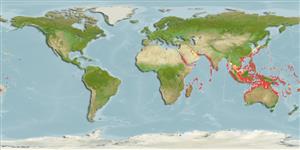Common names from other countries
Environment: milieu / climate zone / depth range / distribution range
экология
морской ассоциированный с рифами; пределы глубины 0 - 55 m (Ref. 26165), usually 5 - 35 m (Ref. 27115). Tropical; 22°C - 28°C (Ref. 27115); 35°N - 36°S, 24°E - 169°W
Indo-West Pacific: Red Sea and Natal, South Africa to Niue (Ref. 37816), north to Japan, south to Australia. Recorded from Europa Island (MNHN 1992-0508).
Size / Вес / Возраст
Maturity: Lm ? range ? - ? cm
Max length : 15.0 cm TL самец/пол неопределен; (Ref. 9710); 7.0 cm TL (female)
колючие лучи спинного плавника (общее число) : 10; членистые (мягкие) лучи спинного плавника (общее число) : 15 - 17; колючие лучи анального плавника: 3; членистые (мягкие) лучи анального плавника: 6 - 7. Color patterns vary from one locality to another.
Adults are found above coral outcrops or patch reefs of clear lagoons, channels, or outer reef slopes. Form large aggregations. Feed on zooplankton (Ref. 6113). A protogynous hermaphrodite (Ref. 55367). Males are territorial and haremic (Ref. 9710). Color patterns and size of sexual transition very slightly from one locality to the next. Total length for females from Ref. 9137.
Life cycle and mating behavior
Maturities | размножение | Spawnings | Egg(s) | Fecundities | личинки
Pelagic spawner. A monandric species (Ref. 55367). Females are induced to change sex by removal of males from social groups (Ref. 38802). Sex-reversal is completed in 2-4 weeks after male removal in the area, or 170-280 days in an all female group (Ref. 34185, 34249, 34250). Length at sex change = 5.0 cm TL (Ref. 55367). Also Ref. 103751.
Successful males spawn nightly with successive females (Ref. 37816).
Randall, J.E., G.R. Allen and R.C. Steene, 1990. Fishes of the Great Barrier Reef and Coral Sea. University of Hawaii Press, Honolulu, Hawaii. 506 p. (Ref. 2334)
Статус Красного Списка МСОП (Ref. 130435)
CITES (Ref. 128078)
Not Evaluated
Угроза для людей
Harmless
Использование человеком
рыболовство: не имеет хозяйственного значения; аквариум: коммерческий
дополнительная информация
инструменты
Специальные отчеты
Скачать в формате XML
ресурсы в Интернет
Estimates based on models
Preferred temperature (Ref.
115969): 24.3 - 28.9, mean 27.6 (based on 1000 cells).
Phylogenetic diversity index (Ref.
82804): PD
50 = 0.5000 [Uniqueness, from 0.5 = low to 2.0 = high].
Trophic level (Ref.
69278): 3.4 ±0.45 se; based on food items.
устойчивость к внешним воздействиям (Ref.
120179): высокий, минимальное время удвоения популяции до 15 месяцев (K=0.6).
Fishing Vulnerability (Ref.
59153): Low vulnerability (23 of 100).
